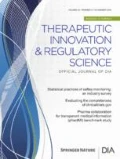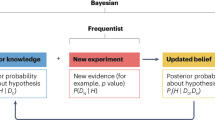Abstract
The number of statistical challenges facing regulators remains high, as does the importance of statistical thinking in the regulatory decision-making process. Statisticians in the Office of Biostatistics at the US Food and Drug Administration review hundreds of new drug and therapeutic biologic applications each year and advise sponsors on protocols numbering in the thousands. In addition to remaining up to date on the newest statistical methods, statisticians are often called upon for innovative approaches to difficult regulatory problems. This article presents the author’s view of the important role that statisticians play in regulatory decision making, beginning with a broad overview of current office initiatives, including the development of guidance documents and a recent push for open and transparent collaboration with industry on methods development. Several recent examples are provided to illustrate the impact that statisticians can have on regulatory decisions through the use of strategic quantitative thinking. Also discussed are areas where it is believed that innovative statistical solutions or greater clarity on existing approaches is still needed.
Similar content being viewed by others
References
Segreti AC, Leung HM, Koch GG, Davis RL, Mohberg NR, Peace KE. Biopharmaceutical statistics in a pharmaceutical regulated environment: past, present, and future. J BioPharm Stat. 2001;11(4):347–372.
O’Neill RT. Promoting the science of regulatory decision-making. AMSTAT News. August 2013:22–23.
Rodriguez RN. Big data and better data. AMSTAT News. June 2012:3–4.
Schenker N, Davidian M, Rodriguez RN. The ASA and big data. AMSTAT News. June 2013:3–4.
Walker D, Fung K. Big data and big business: should statisticians join in. Significance. August 2013.
FDA Center for Drug Evaluation and Research (CDER) strategic plan 2013–2017. Food and Drug Administration website. https://www.fda.gov/AboutFDA/CentersOffices/OfficeofMedicalProductsandTobacco/CDER/default.htm. Updated November 25, 2013. Accessed November 25, 2013.
Clinical Trials Safety Graphics home page. CTSPEDIA website. https://www.ctspedia.org/do/view/CTSpedia/StatGraphHome. Updated September 20, 2013. Accessed September 25, 2013.
Presentations from the FDA/PhUSE Annual Computational Science Symposium. Pharmaceutical Users Software Exchange (PhUSE) website. https://www.phuse.eu/CSS2013-Presentations.aspx. Updated July 9, 2013. Accessed September 25, 2013.
Center for Drug Evaluation and Research clinical/medical guidance documents. Food and Drug Administration website. https://www.fda.gov/Drugs/GuidanceComplianceRegulatoryInformation/Guidances/ucm064981.htm. Updated June 14, 2013. Accessed September 25, 2013.
Chuang-Stein C, Beltangady M. Reporting cumulative proportion of subjects with an adverse event based on data from multiple studies. Pharm Stat. 2010;10:3–7.
Meeting materials for the June 5–6, 2013 Joint Meeting of the Endocrinologic and Metabolic Drugs Advisory Committee (EMDAC) and Drug Safety and Risk Management Advisory Committee (DSaRM). Food and Drug Administration website. https://www.fda.gov/AdvisoryCommittees/CommitteesMeetingMaterials/Drugs/EndocrinologicandMetabolicDrugsAdvisoryCommittee/ucm331504.htm. Updated June 3, 2013. Accessed September 5, 2013.
National Research Council of the National Academies. The Prevention and Treatment of Missing Data in Clinical Trials. Washington, DC: National Academies Press; 2010.
Meeting materials for the January 30, 2013 Meeting of the Pulmonary-Allergy Drugs Advisory Committee Meeting. Food and Drug Administration website. https://www.fda.gov/AdvisoryCommittees/CommitteesMeetingMaterials/Drugs/Pulmonary-AllergyDrugsAdvisoryCommittee/ucm338461.htm. Updated February 6, 2013. Accessed September 5, 2013.
Meeting materials for the September 10, 2013 Meeting of the Pulmonary-Allergy Drugs Advisory Committee. Food and Drug Administration website. https://www.fda.gov/AdvisoryCommittees/CommitteesMeetingMaterials/Drugs/Pulmonary-AllergyDrugsAdvisoryCommittee/ucm367409.htm. Updated September 6, 2013. Accessed September 8, 2013.
CDER guidance for industry: qualification process for drug development tools. Draft guidance. Food and Drug Administration website. https://www.fda.gov/downloads/Drugs/GuidanceComplianceRegulatoryInformation/Guidances/UCM230597.pdf. Updated June 24, 2013. Accessed September 25, 2013.
CDER guidance for industry: enrichment strategies for clinical trials to support approval of human drugs and biological products. Draft guidance. Food and Drug Administration website. https://www.fda.gov/downloads/Drugs/GuidanceComplianceRegulatoryInformation/Guidances/UCM332181.pdf. Updated June 24, 2013. Accessed September 25, 2013.
Meeting materials for the FDA Public Workshop: Innovations in Breast Cancer Drug Development—Neoadjuvant Breast Cancer Workshop. Food and Drug Administration website. https://www.fda.gov/drugs/newsevents/ucm339396.htm. Updated April 11, 2013. Accessed September 5, 2013.
Lawrence JP, Hung J, Wang S-J. Is pulmonary vascular resistance index predictive of exercise tolerance in adult patients with idiopathic pulmonary arterial hypertension. Contemp Clin Trials. 2012;33:1217–1224.
Spellberg B, Guidos R, Gilbert D, et al. The epidemic of antibiotic-resistant infections: a call to action for the medical community from the Infectious Diseases Society of America. Clin Infect Dis. 2008;46:155–164.
Alemayehu D, Quinn J, Cook J, Kunkel M, Knirsch CA. A paradigm shift in drug development for treatment of rare multi-drug resistant Gram-negative pathogens. Clin Infect Dis. 2012;55(4):562–567.
FDA News Release: New FDA task force will support innovation in antibacterial drug development. Food and Drug Administration website. https://www.fda.gov/NewsEvents/Newsroom/PressAnnouncements/ucm320643.htm. Updated September 24, 2012. Accessed December 2, 2013.
Food and Drug Administration. New approaches to antibacterial drug development; request for comments. Federal Register. https://federalregister.gov/a/2013-12925. Published May 31, 2013.
CTTI antibacterial drug development: statistical issues think tank. Clinical Trials Transformation Initiative website. https://www.ctti-clinicaltrials.org/what-we-do/investigational-plan/abdd/meetings/think-tank. Accessed December 2, 2013.
Meeting materials from the Brookings Council on Antibacterial Drug Development Meeting #1. The Brookings Institution website. https://www.brookings.edu/events/2012/08/30-antibacterial-drug-development. Accessed September 25, 2013.
CDER guidance for industry: providing clinical evidence of effectiveness for human drug and biological products. Food and Drug Administration website. https://www.fda.gov/downloads/Drugs/GuidanceComplianceRegulatoryInformation/Guidances/UCM072008.pdf. Updated June 14, 2013. Accessed September 25, 2013.
Huque MF, Alosh M, Dubey SD. P-values, evidence and multiplicity considerations for controlled clinical trials. In: Encyclopedia of Biopharmaceutical Statistics. New York, NY: Marcel Dekker; 2003:696–706.
Follmann D, Brittain E, Powers J. Discordant MIC analysis: a new path to licensure for anti-infective drugs. Clin Trials. 2013;10(6):876–885.
Hobbs BP, Carlin BP, Sargent DJ. Adaptive adjustment of the randomization ratio using historical control data. Clin Trials. 2013;10(3):430–440.
Gamalo MA, Tiwari RC, LaVange LM. Bayesian approach to the design and analysis of non-inferiority trials for anti-infective products [published online August 5, 2013]. Pharm Stat. Available at https://wileyonlinelibrary.com. doi:https://doi.org/10.1002/pst.1588.
Permutt T. Utility analysis of varenicline in smoking cessation Paper presented at: annual meeting of the International Chinese Statistical Association (ICSA) June 10–12, 2013; Bethesda, MD.
International Conference on Harmonisation of Technical Requirements for Registration of Pharmaceuticals for Human Use (ICH). ICH Harmonised tripartite guideline: statistical principles for clinical trials. Stat Med. 1999;18:1905–1942.
Permutt T. Multiplicity in regulatory statistical review. Stat Biopharm Res. 2013;5(4):394–401.
Stafford PG, Garrett A. Using real-time data to drive better decisions, faster. Drug Inf J. 2011;45(4):495–502.
Venet D, Doffagne E, Burzykowski T, et al. A statistical approach to central monitoring of data quality in clinical trials [published online June 8, 2012]. Clin Trials. https://ctj.sagepub.com/content/early/2012/06/08/1740774512447898.
Herbst R, Rubin E, LaVange LM, et al. Design of a disease-specific master protocol. Issue brief presented at: Conference on Clinical Cancer Research, Friends of Cancer Research and Brookings Engelberg Center for Health Care Reform; Washington, DC; November 14, 2012.
Ledford H. “Master protocol” aims to revamp cancer trials. Nature. 2013;498:146–147.
CDER guidance for industry: adaptive design clinical trials for drugs and biologics. Draft guidance. Food and Drug Administration website. https://www.fda.gov/downloads/Drugs/GuidanceComplianceRegulatoryInformation/Guidances/UCM201790.pdf. Updated June 24, 2013. Accessed September 25, 2013.
Campbell G. Similarities and differences of Bayesian designs and adaptive designs for medical devices: a regulatory view. Stat Biopharm Res. 2013;5(4):356–368.
Campbell G. Bayesian statistics in medical devices: innovation sparked by the FDA. J Biopharm Stat. 2011;21(5):871–887.
Institute of Medicine of the National Academies. Ethical and Scientific Issues in Studying the Safety of Approved Drugs. Washington, DC: National Academies Press; 2012.
McEvoy BW, Nandy RR, Tiwari RC. Bayesian approach for clinical trial safety data using an Ising prior. Biometrics. 2013;69(3):661–672.
Rodriguez RN. Statistical leadership: preparing our future leaders. AMSTAT News. February 2012:3–4.
Rodriguez RN. Career success training for statisticians: a progress update. AMSTAT News. October 2012:3–4.
Author information
Authors and Affiliations
Corresponding author
Additional information
Author Notes
Portions of this manuscript were presented at the DIA China Quantitative Science Forum, October 20–21, 2013, Beijing, China.
Rights and permissions
About this article
Cite this article
LaVange, L.M. The Role of Statistics in Regulatory Decision Making. Ther Innov Regul Sci 48, 10–19 (2014). https://doi.org/10.1177/2168479013514418
Received:
Accepted:
Published:
Issue Date:
DOI: https://doi.org/10.1177/2168479013514418




